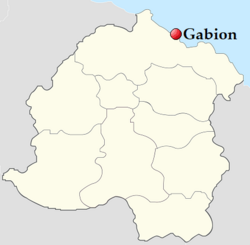Gabion
Script error: The module returned a nil value. It is supposed to return an export table.
Gabion | |
|---|---|
City | |
| Motto(s): Per mare ad coelum From Sea to Heaven | |
 Gabion inside Yonderre | |
| Nation | |
| County | Gabion |
| Founded | 1472 |
| Founded by | Guillaume de Houicourt |
| Government | |
| • Type | Gabion City Council |
| • Count of Vandarcôte | Gerard de Houicourt |
| • Castellan-Steward of Gabion | Jean-Baptiste Gardeaux (SD) |
| Area | |
| • Total | 2,235 km2 (863 sq mi) |
| Population (2025) | |
| • Total | 7,842,000 |
| • Density | 3,508.725/km2 (9,087.56/sq mi) |
| Demonym(s) | Gabionesc Gabionic |
Gabion is the second largest city of the Serene Grand Duchy Yonderre and the capital of Vandarcôte County. Gabion stands at the eastern estuary of the Peritonne river that makes up the Gulf of Gabion of the southern Vandarch coast. With 7.84 million citizens in its metropolitan area, Gabion is the largest city on the Vandarch and makes up almost 8% of Yonderre's total population.
Often viewed as the second capital of Yonderre, Gabion was founded in 1472 by the Derian nobleman and Knight of the Oblong Table Guillaume de Houicourt when he in the image of Collinebourg let his castle Gabionbourg be built on a sparsely populated stretch of coastline in northern Yonderre. Local Gothic settlements centred around fishing had existed on and around the site since neolithic times. Settlers soon came from the Holy Levantine Empire when Gabion entered a state of mercantile symbiosis with Collinebourg, the latter shipping goods by the Peritonne river to Gabion from whence they would ship out into the Vandarch at large. Gabion would remain the most important trade city in Yonderre for sea-based trade into the Age of Enlightenment due to its strategic location at the south of the Vandarch. In the aftermath of the Great Fire of Collinebourg in 1728, Gabion took on a new role as the cultral capital of Yonderre. Having already been a favourite holiday destination for the wealthy, Gabion would become home to many notable thinkers and scientists of the eighteenth century, swelling the ranks of Gabion University founded in 1669.
Through to the current day, this dynamic of Collinebourg as the legal and political capital and Gabion as the cultural and economic capital remains strongly entrenched in the ethos of both cities. This duality has also continued the rivalry between Gabion and Collinebourg, especially in sports at both the collegiate and professional levels. It has also led to a lot companies maintaining dual headquarters, one in Gabion focused on business operations and in Collinebourg focused on lobbying the government and government/legal affairs. While national embassies are largely kept in Collinebourg, many nations also maintain consulates in Gabion.
With the advent of cinema in the very late nineteenth century, Gabion became central to the Yonderian film industry which itself became influential on global filmmaking. Komeon Boulevard, a neighbourhood of Gabion, has become a shorthand reference for the Yonderian film industry and the people associated with it. Gabion remains an important cultural and economic powerhouse in the Vandarch region to this day. Gabion is an international tourism destination, being the most popular in Yonderre by number of visitors. As the cultural heartland of Yonderre, Gabion serves as the home of numerous Yonderian artists, scientists, and sports figures due to the presence of its various museums, academic and political institutions and theaters.
Etymology
The city of Gabion takes its name from the Gabionbourg Castle around which it was built. Gabionbourg Castle takes its name from a style of fortifications employed during the early stages of its construction.
Sister cities
Calfeld, Urcea
 Port Diteaux, Burgundie
Port Diteaux, Burgundie
Notes
- Pages with non-numeric formatnum arguments
- Pages using duplicate arguments in template calls
- Pages using infobox settlement with possible motto list
- Pages using infobox settlement with possible demonym list
- Pages using infobox settlement with no coordinates
- Yonderre
- Cities
- Cities in Yonderre
- Gabion
- Canonical Article





